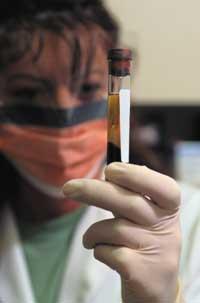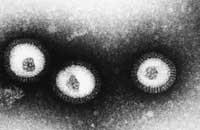Infectious diseases, new diseases
2001/05/01 Arrese, Elixabete | Basaras, Miren - Mikrobiologiako Irakasle Titularra Iturria: Elhuyar aldizkaria

Among these new microorganisms is the human immunodeficiency virus (HIV) that causes AIDS, while among the reappeared microorganisms is epidemic cholera or tuberculosis. For all this, numerous books and articles have been published and a new journal has been published to spread information about these microorganisms, the journal Emerging Infectious Diseases.
Most pathogenic microorganisms discovered are responsible for human diseases. Table 1 shows the new microorganisms found in the last twenty years, indicating when they were found, what type of microorganisms they are and what diseases they cause. As seen, most are viruses, but there are bacteria and also prions.
The damage caused by a microorganism is called pathogenesis or pathogenicity to produce an infectious disease. The pathogenesis is represented as a triangle and in each vertex is the host (the man), the medium and the microorganism. The interaction of these three components will cause disease in the human being.
For this purpose, the presence of the microorganism itself, the appropriate conditions for its pollution and the overcoming of its limits of defense is necessary.
Why are new microorganisms created?
There are many factors that contribute to the diffusion of newly discovered microorganisms and the appearance of the disease, but most are related to the growth of the population and mobility throughout their world.

The fact that people travel around the world means the extension of the microorganism, since in some regions they can transfer microorganisms and endemic or local diseases to other regions. Examples of this are African malaria, Hong Kong flu, and the West Nile virus that appeared in New York two years ago.
The West Nile virus is endemic in Europe, Africa and Asia and mainly attacks birds. In North America it did not exist, but it is believed that a contaminated bird was moved to New York and the virus caused the deaths of thousands of birds and 9 people. Today they believe that the virus persists and fear spreading to other regions of America.
Therefore, in addition to human displacement, the transport of animals can be a pathway for the transmission of diseases. Among them are the Marburg or the Ebola virus, carried by the monkeys. Through the monkeys, the virus was transported from Africa to Germany and the United States. Pathogens do not respect national borders.
On the other hand, the growth of the population (overpopulation) and aging, hygiene problems and inadequate sanitation infrastructure favor the development of microorganisms.
YEAR | AGENT AGENT | DISEASE |
1980 | Human lymphotropic virus type I | Adult T-cell lymphoma/leutzemia |
1982 1982 1982 1982 1982 | Human lymphotropic virus type II | Abnormal T Cell Leukemia |
1982 1982 1982 1982 1982 | Borrelia burgdorferi | Lyme Disease |
1983 1983 - 1983 | Human immunodeficiency virus (HIV-1, HIV-2) | Acquired immunodeficiency syndrome |
1983 1983 - 1983 | Helicobacter pylori pylori | Gastritis, gastric ulcer |
1983 1983 - 1983 | Escherichia coli 0157:H7 | Hemorrhagic colitis |
1988 | Human herpes virus 6 | Spontaneous exanthema (child roséola) |
1989 1989 1989 1989 | Ehrlichia spp. | Human relquiosis |
1989 1989 1989 1989 | Hepatitis C virus | Hepatitis no A no B transmitted by Via Parenteral |
1990 1990 1990 1990 1990 1990 | Human herpes virus 7 | Spontaneous exanthema, pitiriasis |
1990 1990 1990 1990 1990 1990 | Hepatitis E virus | Hepatitis no A no B transmitted by stool |
1991 | Hepatitis F virus | No-A no - Severe hepatitis B |
1992 1992 1992 1992 1992 1992 | Vibrio cholerae 0139:H7 | Epidemic cholera (new strain) |
1992 1992 1992 1992 1992 1992 | Bartonella henselae | Angiomatosis by bacilli |
1993 1993 1993 1993 1993 | Virus “without name” | Pulmonary syndrome by inflammation |
1993 1993 1993 1993 1993 | Hepatitis G virus | Hepatitis no A no C ? |
1994 1994 1994 1994 1994 | Virus Sabia | Brazilian Hemorrhagic Fever |
1994 1994 1994 1994 1994 | Human herpes virus 8 | Kaposi Sarcoma |
1995 | Hendravirus | Meningitis, encephalitis |
1996 1996 1996 1996 1996 1996 | Prions (Bovine spongiform encephalopathy ?) | New variant of Creutzfeldt-Jakob disease |
1997 1997 1997 1997 1997 | Influenza A virus (H5N1) | Influenza (Hong Kong) |
1997 1997 1997 1997 1997 | 71 Enterovirus (EV71) | Epidemic encephalitis |
1997 1997 1997 1997 1997 | Transfusion-borne virus (TTV) | Hepatitis no A no G ? |
1998 1998 1998 1998 1998 1998 | Nipahvirus virus | Meningitis, encephalitis |
1999 1999 1999 | Influenza A virus (H9N2) | Influenza (Hong Kong) |
1999 1999 1999 | West Nile Virus (Type 1) | Encephalitis (New York) |
2000 | PMV virus | ? ? |
For example, although the hepatitis E virus is transmitted through the feces, if they contaminate the water, the water also becomes a source of infection. The same happens with many other diseases and that is why water is a source of primary infections: 5 million people die every year around the world due to the presence of pathogenic microorganisms in contaminated waters.

Ecological changes are also a factor to take into account, since changes in land use (deforestation and reforestation) alter the environment and the place of deposit of microorganisms. For example, deforestation in the east of the United States and subsequent reforestation generated a different forest in which the deer population increased. But the closeness of humans, mice, deer and ticks caused the disease called Lyme to appear in 1982. Since then the disease has spread and currently Lyme disease also exists here. In the United States also appeared in 1993 a “nameless” virus that caused a serious lung syndrome. It was observed that the virus was related to the abnormal appearance of rodents in homes.
Although it is more difficult to see, the change in medical care can lead to the appearance of a new microorganism. The increased use of prosthesis and catheters and the increase in the use of immunosuppressive drugs (in the case of transplants and cancer) result in a greater generation of opportunistic microorganisms and a greater rapidity and aggressiveness of the disease.
In addition, we must take care of technological and industrial advances. For example, new technologies used in the preparation and conservation of food can have unexpected effects on the safety of microorganisms and, if not properly used, can result in new infections by contaminated food, such as hemorrhagic colitis produced by the bacterium E. coli O157:H7, which was first discovered in improperly made burgers. Or the evil of crazy cows that has become so serious. In fact, the inadequate disinfection procedures used in Britain to obtain livestock feed from animal remains have allowed adapting the disease of sheep scrapie to cattle, creating a bovine spongiform encephalopathy. The latter seems to be related to the new variant of Creutzfeldt-Jakob disease in humans.

Finally, the adaptations and genetic modifications of microorganisms can give rise to new pathogens. Microorganisms are able to be resistant to drugs and to produce antigenic changes. These antigenic changes make antibodies capable of killing these microorganisms in one of them not serve in the following, since the antibody is not able to recognize it due to the changes made by the microorganism. This allows the generation of microorganisms with a different behavior to the original. For example, influenza viruses, created in Hong Kong in 1997 and 1999, caused serious flu problems.
However, basic research and clinical studies for the detection of new microorganisms are essential and facilitate the development of diagnoses, therapies and vaccines.
What can be done against these new microorganisms?
Newly discovered microorganisms and infectious diseases caused by them pose a continuous threat to the world, since although some diseases are controlled by vaccines and drugs, new ones are created. Therefore, the World Health Organization (WHO) has launched a prevention strategy to control these new infectious diseases. The objectives of this strategy are:
- Care and response: strengthen the care of newly found microorganisms, analyze the diseases caused by them and investigate the factors that influence their appearance.
- Applied research: development of tools for the identification and understanding of new infectious diseases, limitation of the causes of risk of chronic diseases and development and evaluation of prevention and control strategies.
- Infrastructure and education: the objectives are aimed at increasing the capacity of international laboratories to know and communicate, both clinically and epidemiologically, new infectious diseases and to respond to the disease as quickly as possible.
- Strengthening the international capacity for prevention and control: with this objective, we aim to develop, evaluate and promote new strategies that contribute to health care and to modify behaviors that facilitate the transmission of microorganisms. Obtaining new vaccines and medications is also part of this goal.
Objectives of the prevention
The claims to be taken into account in the prevention of new infectious or contagious diseases have a double side: on the one hand, the problems of appearance of the disease and, on the other, the population at risk of becoming ill. What is clear is that prevention should be done at all levels and from different perspectives.
On the one hand, to deal with the growing resistance of microorganisms to drugs, it is necessary to create new drugs and carry out campaigns for their correct use, since in some cases this problem is becoming very serious. For example, tuberculosis is strengthening so much.
On the other hand, it is necessary to control vectors, intermediaries that extend diseases, that is, food, water, etc. For this purpose, without modifying the vector habitat, adequate methods of disinfection of water and food should be used.
Blood transfusions also allow the transmission of many diseases, since the blood and its derivatives are suitable for the transport of HIV, Hepatitis C virus, TTV, etc. Therefore, the detection and prevention of these microorganisms will require important blood care, inventing new diagnostic tests.

The prevention of pregnant women, neonates, immunosuppressed, etc., will also be an important task, since they have weak defense mechanisms, which facilitates the appearance of diseases by microorganisms. For example, the transport of microorganisms from the mother to the fetus is very simple. To avoid this, prenatal care and prevention are essential.
Finally, new vaccines will have to be developed. Currently many diseases can be controlled by vaccines (tetanus, polio, measles, parotiditis, rubella...), so it would be important to develop vaccines for the prevention of newly discovered microorganisms.
Taking into account all this and using new scientific knowledge, using well-planned participatory strategies, with adequate resources and with political will or will, you can achieve the prevention of many of these new diseases; immunization, the use of drugs or vector control.
However, this does not mean that a world can be built without evils. Although some diseases can be eliminated, most of them would remain, although with less infectious capacity. Furthermore, it is evident that from now on new microorganisms will continue to be found, although we do not know when or where.
The flu, the importance of careThe flu is a disease known since ancient times and, in fact, the flu has caused many deaths by pandemics, that is, by high intensity epidemics that affects practically all the population of a region. For example, in the 1918 pandemic nearly 40 million people worldwide died.) Pandemics are occasional due to the appearance or reappearance of different types of viruses. In addition to the human being, the flu virus also occurs in mammals and birds and the transmission of the virus can occur among all beings. For all this, the World Health Organization promoted the compulsory surveillance of this virus. The surveillance of the flu has been carried out from 1948 all over the world and in it participate 82 states and 100 laboratories. These laboratories analyze the different types of flu or influenza virus that coexist with us and there the vaccine is invented that is emitted every year. Thanks to the care, in 1997 the immediate identification in a Dutch laboratory of a new variety of flu (H5N1) was achieved. This new variety of viruses infected the chickens and passed the human being becoming mortal. In view of this, other laboratories of the World Health Organization (WHO) were put to work instantly. Epidemiological studies, public information, development of diagnostic tests and agile and effective response to the appearance of the virus were carried out. Fortunately, this flu virus showed poor human transmission capacity and caused few deaths. If I had had time to get the ability to transmit from the human being to the human being, for example through a mutation, I could escape any kind of control. |

Gai honi buruzko eduki gehiago
Elhuyarrek garatutako teknologia





